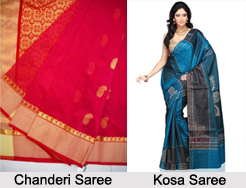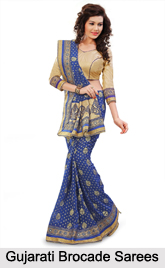 Sarees of West India showcase a wide variety in the variation of sarees and each type carry a distinct character that is typical of this region. The inhabitants of this region prefer to wear heavily decked sarees in occasions like marriage and social gatherings. The affluent women of this region prefer to wear heavily and intricately designed sarees to flaunt the status quo.
Sarees of West India showcase a wide variety in the variation of sarees and each type carry a distinct character that is typical of this region. The inhabitants of this region prefer to wear heavily decked sarees in occasions like marriage and social gatherings. The affluent women of this region prefer to wear heavily and intricately designed sarees to flaunt the status quo.
Designs of West Indian Sarees
The weavers of this region give stress on dyeing rather than weaving techniques and the 3 major forms of Indian resist-dyeing have been developed in this region. These are block-printing, tie-dye and ikat, which culminates in the complex multicoloured patola. The extensive embroidery tradition of west India also emphasize colour, usually mixing many bright hues together with Zari Embroidery. The weavers often include sparkling embellishments such as tinsel, sequins and mirrors in the sarees to create an expressive glitz. Since the ancient tradition, this region has a tendency towards using vibrant hues and sometimes blending or combining them to create different and unique colour combinations.
Different Types of Saree in West India
Sarees of West India have a huge variety as the region showcases the traditional as well as fashionable sarees in abundance. Sarees with metallic-thread embroidery are commonly found in the west, as the western region has a rich embroidery tradition.
•Chanderi Sarees: One of the well acclaimed and coveted sarees of this region is the Chanderi Sarees which is excellent for Indian summers as silk or fine cotton is used as raw material for this type of saree. The designs of these types of sarees are taken from Chanderitemples. This particular saree is identified for the usage of quality gold thread.

•Kosa Sarees: Another saree which is widely used in this region is the Kosa Sarees which is produced in Madhya Pradesh. The weavers of Devangan community weave this type of saree. The natural shine and exclusivity of Kosa saree lie in the fibre used.
•Paithani Sarees: West India is the abode of Paithani sarees which derive the patterns and motifs from Ajanta Caves including peacock, lotus and mango motifs. Intricate designs on pallu and border is a specialty of Paithani Sarees.
•Embroidered Tinsel Sarees: West India is also known for Embroidered Tinsel Sarees. These types of sarees are block-printed or silk-screened, but instead of the pattern being a dye, transparent resinous glue is printed onto the fabric. The artisans, who are involved in weaving these sarees and designing them, use flakes of mica or gold dust to add glitter in the sarees.
•Gujarati Brocade Sarees: The treasure trove of the sarees of West India will remain incomplete without the mention of Gujarati brocade sarees. The traditional brocade sarees have the distinguishable character for the "butis" which are seen woven into the field of the saree in the warp direction instead of the weft. The Gujarati work usually had leaves, flowers and stems outlined by a fine dark line.
As the styles and designs of sarees differ from one state to another, the sarees of West India also have a distinct quality and style that are typical to the region. The sarees of this region have a noticeable character that mirrors the creativity and tradition of West India.





















